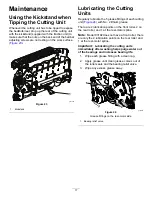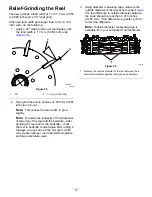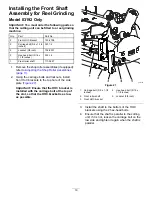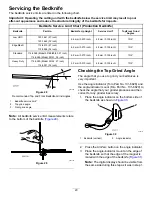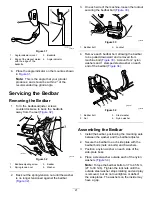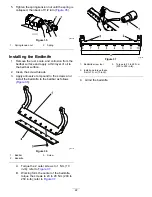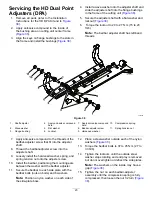
Operation
Refer to your traction unit
Operator’s Manual
for
detailed operation instructions. Before using the
cutting unit each day, adjust the bedknife; refer to
Adjusting the Bedknife to the Reel (page 9)
. Test the
quality of cut by cutting a test swath before using the
cutting unit to ensure that the finished cut is correct.
Adjusting the Cutting Unit
Adjusting the Rear Shield
Under most conditions, you can attain the best
clipping dispersion when the rear shield is closed
(front discharge). When conditions are heavy or wet,
you may open the rear shield.
To open the rear shield (
), loosen the bolt
securing the shield to the left side plate, rotate the
shield to the open position, and tighten the bolt.
g191341
Figure 6
1.
Bolt
2.
Rear shield
Checking the Cutting Unit
The dual knob bedknife-to-reel adjustment system
incorporated in this cutting unit simplifies the
adjustment procedure needed to deliver optimum
mowing performance. The precise adjustment
possible with the dual knob/bedbar design gives
the necessary control to provide a continual
self-sharpening action-thus maintaining sharp cutting
edges, ensuring good quality of cut, and greatly
reducing the need for routine backlapping.
Prior to mowing each day, or as required, check each
cutting unit to verify proper bedknife-to-reel contact.
Perform this procedure even when the quality of
cut is acceptable.
1.
Slowly rotate the reel in a reverse direction,
listening for reel-to-bedknife contact.
Note:
The adjustment knobs have detents
corresponding to 0.022 mm (0.0009 inch)
bedknife movement for each indexed position.
Refer to
Adjusting the Bedknife to the Reel
(page 9)
.
2.
Test the cutting performance by inserting a long
strip of cutting performance paper (Toro Part No.
125-5610) between the reel and the bedknife,
perpendicular to the bedknife (
). Slowly
rotate the reel forward; it should cut the paper.
g003323
Figure 7
Note:
If excessive contact/reel drag is evident,
either backlap, reface the front of the bedknife,
or grind the cutting unit to achieve the sharp
edges needed for precision cutting; refer to
Reel
Mower Basics
, Form No. 09168SL.
Important:
Light contact is preferred
at all times. If you do not maintain light
contact, the bedknife and reel edges will
not sufficiently self-sharpen and will dull
after a period of operation. If you maintain
excessive contact, the bedknife and reel will
wear more quickly and unevenly, and the
quality of cut may be adversely affected.
Note:
After extended running, a ridge will
eventually develop at both ends of the bedknife.
Round off or file these notches flush with the
cutting edge of the bedknife to ensure smooth
operation.
Note:
Over time, you will need to grind the
chamfer (
), as it is only designed to last
40% of the bedknife life.
8

















